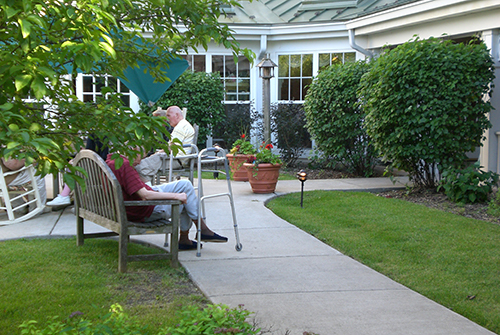 Dr. Susan Rodiek ’98 worked with two Japanese colleagues, Masahiro Toyoda and Yuko Yokota—both landscape design scholars who also practice clinical-level horticultural therapy—and found that daily gardening activities can improve brain health and possibly reduce the risk of dementia.
Dr. Susan Rodiek ’98 worked with two Japanese colleagues, Masahiro Toyoda and Yuko Yokota—both landscape design scholars who also practice clinical-level horticultural therapy—and found that daily gardening activities can improve brain health and possibly reduce the risk of dementia.
Susan Rodiek ’98, associate professor of architecture and a leading expert in therapeutic design for senior living facilities, researches how nature and simple acts like gardening can positively impact the elderly.
Your research focuses on landscape and architectural design for health care settings, often assisted living and nursing facilities. What sparked your interest in this field?
“My research is primarily focused on how elderly people can still have contact with nature, especially as they move into assisted living or nursing facilities. Many years ago, I had an epiphany: As people age, their lives should get better instead of worse. In the past, many people said they would rather die than go into a nursing home, which is a testament to how bad it was at that time. I started to imagine a world where people who moved to a nursing home or assisted living facility could have better lives than they had before. When I pursued my own research during my master’s degree at Texas A&M University, I decided to focus on how architecture and design could improve quality of life for older people.”
What types of spaces do you focus on?
“I’m interested in any building type, whether it’s a home, church, school or park. I believe that any space can be designed in a way that helps people feel happier and more at ease. I work frequently with residential care facilities in small towns, but I also enjoy adaptive re-use projects, which focus on finding ways to utilize the best qualities of older buildings, rather than tearing them down. Almost everything I do has wellness in mind: Is this sustainable? Does it promote physical activity? Things like that.”
You helped write an award-winning study that linked gardening to a reduction in age-related cognitive decline. Tell us about it!
“I worked with two Japanese colleagues, Masahiro Toyoda, a neuroscientist, and Yuko Yokota—both landscape design scholars who also practice clinical-level horticultural therapy. They attached electrodes to different parts of the head that are connected to certain parts of the brain. This allowed us to monitor cognitive processing and stimulation while the subjects—elderly individuals—executed simple gardening tasks like planting and watering a seed. We found a greater increase in oxygenated hemoglobin during the gardening activity, compared with other therapeutic activities commonly used for brain stimulation in older adults. This suggests that daily gardening activities can improve brain health and possibly reduce the risk of dementia. This finding could prove crucial in learning how to delay the onset of dementia and treat those who are already suffering from the disease. More generally, while many people already believe that nature has healing powers, studies like this one provide additional evidence of the therapeutic value of nature.” (The full paper is available to read here.)
How does your role at Texas A&M’s Center for Health Systems & Design and your affiliation with Texas A&M’s Center for Population Health & Aging relate to your research?
“The Center for Health Systems & Design is a joint effort between the College of Architecture and the College of Medicine. I’ve been a faculty fellow since 1999. It’s basically an interdisciplinary advisory group of faculty who research and teach about different aspects of health. We collaborate on funding projects, oversee graduate committees and generally focus on promoting research, innovation and communication for evidence-based planning and design. I’m also a member of the Center for Population Health & Aging. Housed in the School of Public Health, this broad-based collaboration is focused specifically on elderly populations. Through research and community-based programs, it helps promote healthy and successful aging. Studies include chronic disease prevention and management; exploring interactions between health, aging and technology; improving geriatric care; and evaluating economic and policy issues related to population aging.”
 Dr. Susan Rodiek's research is primarily focused on how elderly people can still have contact with nature, especially as they move into assisted living or nursing facilities.
Dr. Susan Rodiek's research is primarily focused on how elderly people can still have contact with nature, especially as they move into assisted living or nursing facilities.
How do you encourage the inclusion of outdoor spaces in your work as an architect with assisted living facilities?
“When I was doing my master’s research, I visited many retirement homes and found that while most of them were fairly comfortable, they usually didn’t have very good access to nature. The only usable outdoor space in a facility might be a concrete pad that was too shady all day or maybe one bench that was hard and uncomfortable to sit on. This inspired me and my team to produce a series of educational videos called “Access to Nature for Older Adults.” These videos show how the layout of a property can be designed to encourage outdoor access, with better location and visibility of outdoor settings, and better support for outdoor activities. It also covers how to design usable outdoor spaces so they are safe for individuals with dementia but also include pleasant greenery and walking and sitting areas.” More information is available at accesstonature.org.
How do you ultimately hope your research will contribute to and improve how our society treats aging populations?
“I want to share everything I’ve learned about how to improve outdoor access and usage, so more senior communities can learn to implement it. Remodeling outdoor spaces is relatively inexpensive—often, all it takes is knowledge and a few simple changes. Residents typically live in a care community for about three and a half years. I want to give people a better outdoor experience during that time so they can go outside and interact with nature—birds, butterflies and plants, for example. People deserve to be healthier and happier for the last years of their lives.”